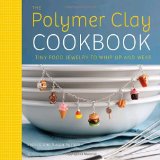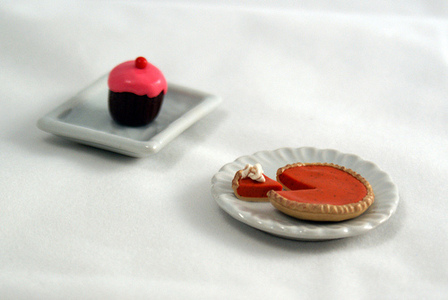

My husband bought our Halloween candy too early again this year — so early, in fact, that we had to buy another bag by the time Halloween actually rolled around. And as luck would have it, we had fewer trick-or-treaters than normal. So now there's post-Halloween candy calling our names, too. Between Halloween leftovers and the temptations of the coming Thanksgiving and Christmas holidays, this time of year can be a dieter's worst nightmare.
But those same temptations make the holidays a foodie's delight. And if you're a foodie, then The Polymer Clay Cookbook: Tiny Food Jewelry to Whip Up and Wear by Jessica and Susan Partain may be just the book for you. As the authors say in the intro, "to celebrate food is, we think, to celebrate life." This book celebrates miniature polymer clay food jewelry, and it serves up the how-tos with a generous helping of food-related memories. The authors even sprinkle in a few edible recipes for good measure.
by Jessica and Susan Partain may be just the book for you. As the authors say in the intro, "to celebrate food is, we think, to celebrate life." This book celebrates miniature polymer clay food jewelry, and it serves up the how-tos with a generous helping of food-related memories. The authors even sprinkle in a few edible recipes for good measure.
The Book
The book is a small one — 7.5" square with 160 pages. It starts with two introductory sections, clay basics and jewelry basics. It then jumps into the mini food projects, which are separated into chapters based on the type of food (fruits, breakfasts, entrees, desserts, and holiday foods). The chapters and the individual projects progress from easiest to hardest.
The introductory chapters were definitely the best part of the book for me. The polymer clay section started with good descriptions of a wide variety of tool options. I like that they had lots of photos of the tools. And they didn't just describe what conditioning was. They showed examples of fully conditioned and not-quite-ready clay. They also had a photo of all the polymer clay colors used in the book, which could come in handy for creating a shopping list.
There's a mini-color lesson, which I thought was very nicely done. If you want a little information about color but don't want to go into all the depth of the Color Inspiration book, this book has a lot of good basics. I especially like the photo where they show the effect of mixing with translucent clay vs. mixing with white clay.
They even included a nice little troubleshooting section covering leaching and softening clay, rescuing burned pieces, and more. (Yay for troubleshooting sections!)
I did have problems with some of their advice, though. For example, they said it was okay to cook clay at a lower temperature for longer, or to bake mixed clays at the lower of the two manufacturer's temps. My understanding (backed up by this) is that clay will not properly cure if you don't bake it hot enough for long enough. So it bothers me when a book, especially one intended for beginners, tells people to disregard package instructions.
I found the "Jewelry Making 101" chapter very useful, with its basics on jewelry and wire. It's just the level of instruction a beginner needs to start making jewelry — or at least the information I would have liked to have when I was getting started. Some of the information, like the the details on the different tools you use for braided steel wire and nylon thread, is useful to me now. I liked the crimping tutorial with its detailed photos, and I appreciated their suggestion for making bead tips more secure. They even include information on how long to make necklaces and bracelets for small children, older children, and adults.
The Projects
The book's 20 projects are each heavily-illustrated, with one small but very clear photo per step. The instructions are well-written. I never found myself confused about what they meant. Granted, these projects are all pretty simple: I finished my first one in 15 minutes, and I doubt any of them would take longer than an hour, even for a beginner.
The book is modeled after a cookbook, so each project starts with an essay recounting the author's memory of that particular food (eating pretzels at the ballpark, for example). I really liked these little food essays for both the recognition of that nostalgic feeling food can give us and for the connection it gives us with the author.
One of my favorite features of this book is the way they use colored, actual-size circles to show how much clay to use for each part of a project. It's big, friendly, and easy to read. Unfortunately, though, it has errors. Both of the projects I tried had a mistake in that part: the cupcake says to use a 3/8" circle of clay, but the circle actually measures 5/8". The pumpkin pie says to use a 5/8" circle of clay, but the circle actually measured 3/8". In both cases, it threw off the rest of the project to have one wrong-sized circle. My advice is to just go by the written clay measurements, or double-check each of their printed circles with a ruler before you start a project. This clay template would also be handy. Too bad about the errors, though, because this was a neat idea.
There were a few projects I really liked the looks of. The photo of their pumpkin pie just plain made me hungry. I also liked these:
- Lemon slice (nice intro to caning)
- Coffee cup (would be a perfect gift for a coffee lover, maybe along with a nice blend of coffee beans)
- Waffle (love the simple tool they suggest for making the indentions)
- Pretzel
The rest of the projects ranged from "meh" (apple, bacon & eggs, gingerbread men) to a firm dislike (banana, hamburger, taco, pizza). The style is more cutesy than realistic, and sometimes they miss the "cute" mark.
Overall, I found the projects section a little underwhelming. While the instructions are well-written and well-illustrated, a good Googler could find instructions for most (if not all) of these individual food items online for free. And while they have a good jewelry mechanics section in the intro, they don't really go into jewelry design. After the instructions for a food item, there's usually a single paragraph instructing you to add an accent bead and hang it from a finding, or attach it to a seed-beaded necklace.
But they do share some good little tips, obviously learned from years of working with these charms. I like their various tricks for hiding headpins and findings in unobtrusive ways. I found it interesting that they roughened the clay before baking to help the glue adhere. I like their use of pastels for a browned lookand their suggestions for using oil pastels with liquid clay.
My Results

I tried the cupcake and the pumpkin pie projects. As I mentioned above, the wrong-sized images showing how much clay to use threw me off. As a result, my cupcake turned out huge. And I had to go back to the kitchen for more allspice when I realized the pumpkin amount was about half of what it should have been. Other than those things, though, I didn't have any problems. The instructions were straight-forward, and the projects were simple but fun.
While I didn't take a picture of it, my favorite project was the Clay-Be-Gone Sugar Scrub. I had used mineral oil before to get clay dyes off my hands, but it hadn't occurred to me to try a scrub. This mixture is perfect for getting clay dyes and remnants out of the grooves in my fingers. And considering that those little clay bits can really mess up a project if they rub off on other colors, the sugar scrub might just be worth the purchase price all by itself.
Summary
- Pros:
- Clay tools and jewelry basics sections have lots of helpful information and photos.
- Simple projects are great for polymer clay beginners.
- Includes a sugar scrub recipe that's wonderful for cleaning clay residue off hands.
- Cons:
- Errors in pictures of how much clay to use can be confusing and cause mistakes.
- Simple food charm instructions together with very basic jewelry design may leave all but the beginner disappointed.
- Who It's Good For:
- Polymer clay beginners and foodies. Teens and older kids should be able to handle these instructions, too.
Reviewed Materials Source / Disclaimer: This book was borrowed from the Central Oklahoma Polymer Clay Guild's library for review purposes. No compensation was received for this review. I always strive to be honest and unbiased in my reviews, but your results with the product may vary.



